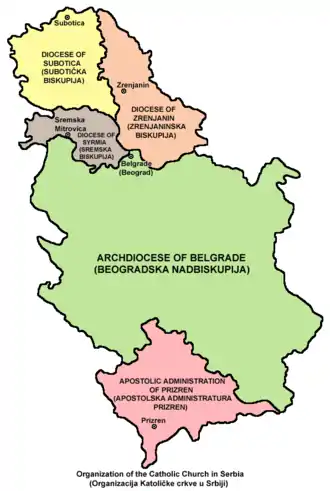Catholic Church in Serbia
The Catholic Church in Serbia (Serbian: Католичка црква у Србији, Katolička crkva u Srbiji) is part of the worldwide Catholic Church in Serbia, under the spiritual leadership of the Pope in Rome. There are 356,957 Catholics in Serbia according to the 2011 census, which is roughly 5% of the population.[1] Estimates in 2020 suggested that the figure had risen to 5.5-6%.[2][3]
| Part of a series on the |
| Catholic Church by country |
|---|
.svg.png.webp) |
|
|
Catholics are mostly concentrated in several municipalities in northern Vojvodina, and are mostly members of ethnic minorities, such as Hungarians and Croats.



History
The first official Concordat between the former Kingdom of Serbia and the Holy See was concluded on 24 June 1914. Through the Second Article of Concordat, it was decided that the regular Archdiocese of Belgrade should be created.[4] Because of the outbreak of the First World War, those provisions could not be implemented, and only after the war were new arrangements made.
In 1918, Serbia became part of the newly formed Kingdom of Yugoslavia. By 1924, the Archdiocese of Belgrade was officially created and the first Archbishop appointed. Negotiations on a new Concordat between the Kingdom and the Holy See were led by the Yugoslav Minister of Justice Ljudevit Auer and Cardinal Eugenio Pacelli (who later become Pope Pius XII). The Concordat was signed in 1935, but was never officially ratified because of a political crisis in Yugoslavia (1936-1937).
Hierarchy
Within Serbia, the Latin Church Catholic hierarchy consists of one archdiocese, three dioceses and one apostolic administration.
| Archdioceses and dioceses | (Arch)bishop | Est. | Cathedral | Weblink |
|---|---|---|---|---|
| Archdiocese of Belgrade Beogradska nadbiskupija |
László Nemet | 1914 | Cathedral of the Blessed Virgin Mary Co-Cathedral of Christ the King |
|
| Diocese of Subotica Subotička biskupija |
Sede vacante | 1923 | Cathedral of Saint Teresa of Avila | |
| Diocese of Zrenjanin Zrenjaninska biskupija |
László Nemet as Administrator | 1923 | Cathedral of St. John of Nepomuk | |
| Diocese of Srijem Srijemska biskupija |
Đuro Gašparović | 2008 | Cathedral Basilica of St. Demetrius | |
| Diocese of Prizren-Pristina Prizrensko–Prištinska biskupija |
Dodë Gjergji | 2000 | Cathedral of Our Lady of Perpetual Succour, Prizren |
In addition, the Greek Catholic Eparchy of Ruski Krstur was established in 2002 for Eastern Catholics of the Byzantine Rite in Serbia and Montenegro. In 2013, jurisdiction of the Eparchy was reduced to Serbia only.[5]
The Diocese of Srijem is a suffragan of the Archdiocese of Đakovo-Osijek in Croatia. Since 2000, Kosovo is under the Diocese of Prizren-Pristina,[6] which also covers some Albanian-populated parts of southern Serbia.
Statistics
| 1921 census[7] | 1991 census | 2002 census | 2011 census | |||||
|---|---|---|---|---|---|---|---|---|
| Number | % | Number | % | Number | % | Number | % | |
| Catholics | 751,429 | 17.16 | 496,226 | 6.4 | 410,976 | 5.48 | 356,957 | 4.97 |
| Total population | 4,378,595 | 100 | 7,759,571 | 100 | 7,498,001 | 100 | 7,186,862 | 100 |
Bishops' Conference of St. Cyril and Methodius
The International Bishops' Conference of Saints Cyril and Methodius is the International Catholic Episcopal Conference that includes Serbia, Kosovo, Montenegro and Macedonia. Permanent members are the Catholic bishops and archbishops from the four countries. Two bishops are authorized (Apostolic Exarchate) for jurisdictional districts of the Byzantine rite. As of 2012, the Chairman of the Conference is the Archbishop of Bar Zef Gashi. The conference is a member of the Council of European Bishops' Conferences.
Further reading
- Andrić, Stanko (2016). "Saint John Capistran and Despot George Branković: An Impossible Compromise". Byzantinoslavica. 74 (1–2): 202–227.
External links
References
- See: Demographics of Serbia
- Catholics and Culture website, retrieved 2023-08-08
- The ARDA website, retrieved 2023-08-28
- Concordat between the Holy See and the Realm of Serbia in 1914
- International Bishops' Conference of St. Cyril and Methodius: Apostolic Exarchate of Serbia and Montenegro (Byzantine)
- International Bishops' Conference of St. Cyril and Methodius: Apostolic Administration of Prizren
- Svetlana Radovanović (1995). Demographic Growth and Ethnodemographic Changes in the Republic of Serbia.
{{cite book}}:|work=ignored (help)